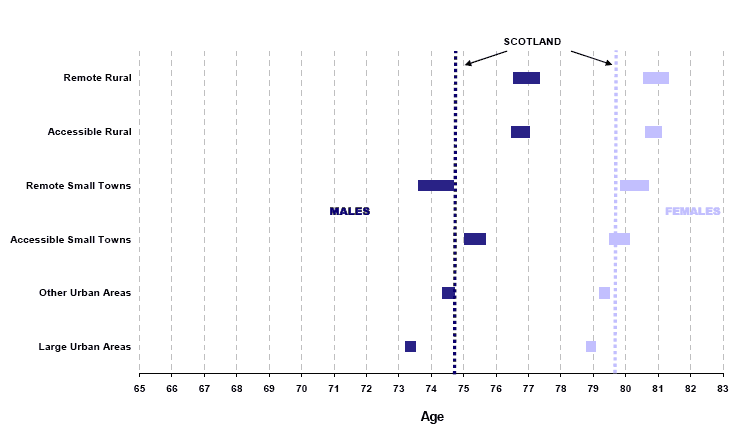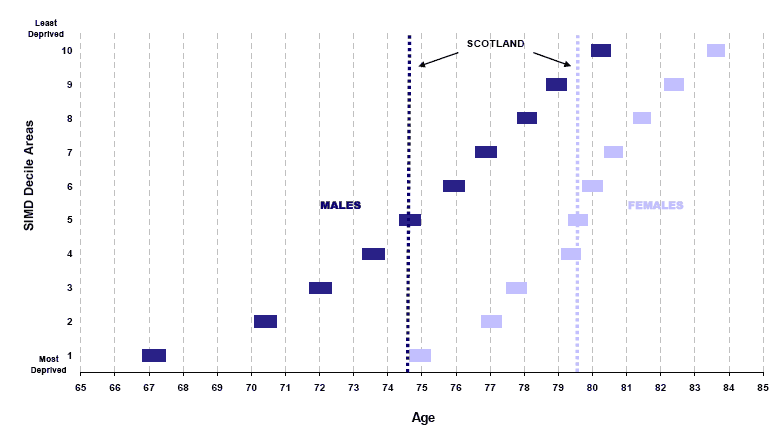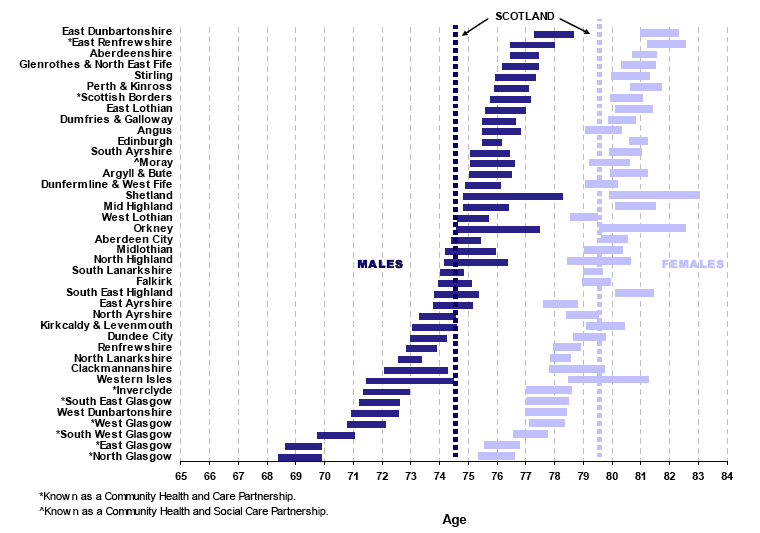
2. Discussion of Results
Men have a shorter life expectancy than women both in Scotland generally and within each CHP, Urban/Rural and Deprivation area. There is however much variation from place to place.
2.1 Life Expectancy at Birth by Urban/Rural Classification
Table 1, Table 6 and Figure 1 show that the lowest male life expectancy figure, 73.4 years, was for men living in Large Urban areas. Remote Rural areas and Accessible Rural areas had the highest life expectancy figures (76.9 years and 76.7 years respectively).
The pattern for women was very similar, although their life expectancy was invariably higher. Women living in Large Urban areas had the shortest life expectancy (78.9 years) and those living in Rural areas — Remote and Accessible — the longest (at 80.9 and 80.8 years respectively).
In all Urban and Rural areas, female life expectancy (at birth) was longer than male life expectancy. However, Figure 1 shows the gap between male and female life expectancy was widest in Remote Small Towns — where men could expect to live 74.1 years from birth but women could expect to live 80.3 years — over 6 years longer.
Figure 1 also shows that people in Large Urban areas had a slightly shorter life expectancy at birth than the Scottish average (for males, the difference was 1.2 years and for females 0.7 years). At the other end of the scale, people in Accessible Rural and Remote Rural areas lived longer than the Scottish average (over 2 years extra for men and over 1 year extra for women). The differences in life expectancy at age 60 were narrower, but 60 year old people living in Remote Rural areas could still look forward to a lifespan approximately 18 months longer than the Scottish average. 60 year olds living in Remote Rural areas could expect to live about a further 2 years beyond that of their counterparts in Large Urban areas.
Figure 1: Life expectancy at birth with 95% confidence intervals for Scottish Urban/Rural Classification areas, 2004-2006 (Males & Females)

2.2 Life Expectancy at Birth by SIMD Deprivation Areas
Male and female life expectancy in each deprivation decile, quintile and vigintile is shown in Table 2, Table 3, Table 4 and Table 7. Figure 2 illustrates male and female life expectancy in each deprivation decile.
Men born in the 10% least deprived areas of Scotland could expect to live for 80.2 years — 13.1 years longer than in the 10% most deprived areas (67.1 years).
Female life expectancy shows a very similar pattern, but again invariably higher. In the 10% least deprived areas women could expect to live for 83.6 years, but women in the 10% most deprived had an expected lifespan of 75.0 years — 8.6 years shorter.
Figure 2 shows a smooth trend of decreasing life expectancy with increasing deprivation. Figure 2 also illustrates that, as deprivation decreased, the gap between male and female life expectancy decreased. For example, in the 10% most deprived areas, women could expect to live 7.9 years more than males but, in the 10% least deprived areas, this gap was shortened to 3.4 years.
People in the 10% most deprived areas had a shorter life expectancy at birth than the Scottish average (7.5 years less for men and 4.6 years less for women). On the other hand, people in the 10% least deprived areas lived longer than the Scottish average (5.6 years more for men and 4.0 years more for women). The differences in life expectancy at age 60 were narrower, but 60 year old men in the 10% least deprived areas could still look forward to a lifespan 3.2 years longer than the Scottish average and 6.8 years longer than men in the 10% most deprived areas. Similarly for females, life expectancy at age 60 in the 10% least deprived areas was 2.7 years longer than the Scottish average and 5.4 years longer than women in the 10% most deprived areas.
Figure 2: Life expectancy at birth with 95% confidence intervals for Scottish Index Multiple Deprivation 2006 Decile area, 2004-2006 (Males & Females)

2.3 Life Expectancy at Birth by Community Health Partnership Areas
Male and female life expectancy at birth, for each CHP area, is shown in Table 5, Table 8 and Figure 3.
Male life expectancy was shortest for those living in North Glasgow, East Glasgow and Southwest Glasgow (69.2, 69.3 and 70.4 years respectively). Men living in these areas could expect a life span 5.4, 5.3 and 4.2 years (respectively) shorter than the Scottish average. Their counterparts in 14 other CHPs also had a lower life expectancy than the Scottish average (see Figure 3).
In contrast, male life expectancy was at its highest in East Dunbartonshire (78.0 years), East Renfrewshire (77.2 years) and Aberdeenshire (77.0 years) — 3.4, 2.6 and 2.4 years (respectively) longer than the Scottish average. This is consistent with the fact that Glasgow City was the local authority area with the poorest life expectancy and East Dunbartonshire the best, according to the life expectancy figures published in September 2007 (in Life Expectancy for Administrative Areas within Scotland, 2004-2006).
Women had longer life expectancy at birth than men. North Glasgow, East Glasgow and Southwest Glasgow again had the shortest female life expectancy at 76.0, 76.2 and 77.2 years. Women living in these areas could expect a shorter lifespan than the Scottish female average — by 3.6, 3.4 and 2.4 years respectively for the three poorest CHPs. A further 13 CHPs also had a lower life expectancy than the Scottish average (see Figure 3).
On the other hand, at the opposite end of the scale East Renfrewshire had the highest female life expectancy at 81.9 years, followed by East Dunbartonshire and Shetland (81.7 and 81.5 years) — about 2 years longer than the Scottish average. Again this matched the picture at local authority level: Glasgow City had the lowest female life expectancy and East Renfrewshire the highest in the September 2007 Life Expectancy for Administrative Areas within Scotland, 2004-2006 publication.
The gap between the CHP with the shortest male life expectancy at birth and the CHP with the longest was 8.8 years. This gap was narrower for females at 5.9 years. The differences in life expectancy at age 60 were narrower, but 60 year old men living in Shetland could still look forward to a lifespan 2.2 years longer than the Scottish average and 5.7 years longer than men living in East Glasgow. Similarly, 60 year old women living in Shetland could look forward to a lifespan 2 years longer than the Scottish average and 4.4 years longer than their counterparts in North Glasgow.
Figure 3: Life expectancy at birth with 95% confidence intervals for Scottish Community Health Partnership Areas, 2004-2006 (Males & Females)
